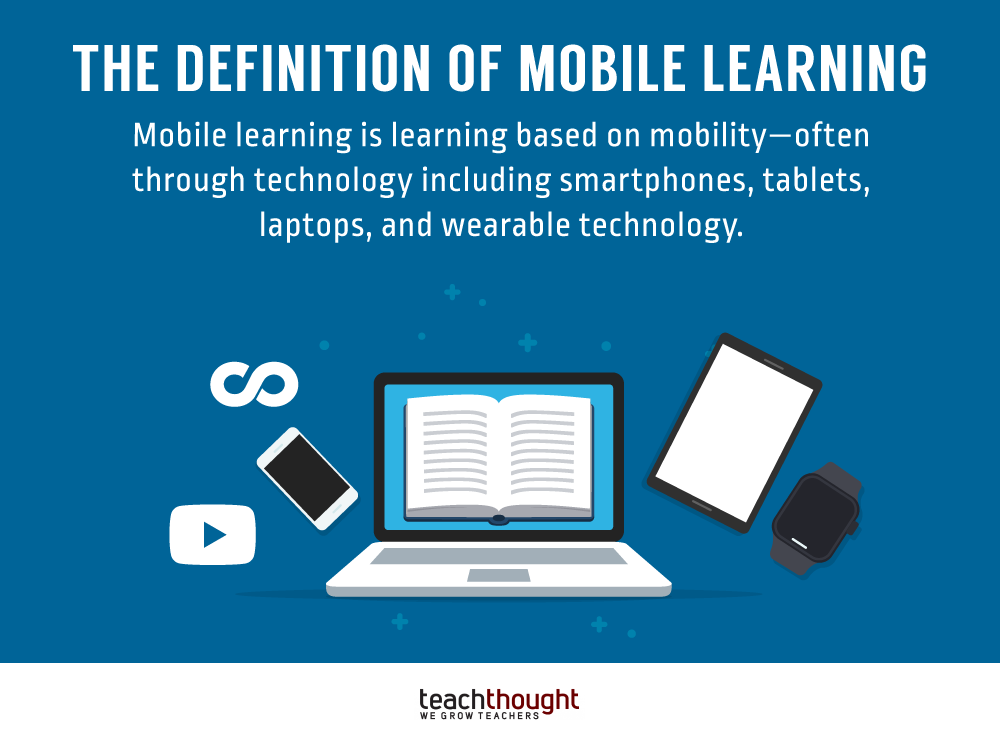
Mobile Learning: A Definition
by Terry Heick
What is the definition of mobile learning?
For starters, let’s agree that mobile learning is learning based on mobility often through mobile devices like laptops and smartphones, iPads, and wearable technology.
Of course, there’s more to it than that. Years ago, I created a graphic that laid out some of the principles of mobile learning, which included Access, Transparency, Self-Actuation, and Metrics.
For a briefer definition of mobile learning, we might offer that it is ‘a kind of learning characterized by the need and ability of the learner to be mobile.’ And that’s a critical difference.
Mobile technology as it is commonly used in public education today is characterized primarily by being ‘1:1’–that is, each student getting their own screen. This could theoretically be used to personalize learning for students. They no longer have to ‘share’ one teacher or a single chalkboard, whiteboard, projected screen, etc., but don’t have to move to a ‘computer lab’ to make that happen.
In this case, the classroom becomes the computer lab.
But of course, education just isn’t there yet. Personalized learning only happens in spurts and pockets, unevenly and inconsistently are rarely in ways that change lives for students (as 13 years of schooling absolutely should).
One of its existing characterizations is the use of mobile technology, including smartphones and tablets. Eventually the kind of technology used to support the learner in acquiring data, making connections, and other meaning-making strategies will change.
Wearable technology is one example–the functions of now handheld tech will shrink and be worn. This will change how the data is both acquired and communicated–haptic feedback, gyro and GPS sensing, bendable ‘hardware,’ increasing intelligent location-based alerts, and other features will replace existing type-and-swipe interactions.
This will, in turn, affect the kinds of data learners seek; pinch-and-zoom maps, for example, will likely no longer require pinching and zooming and may become active (pushing out data, directions, changes to routes, traffic, retailer information, etc.) rather than passive (requiring user input to return data/results).
The Fundamental Pieces Of Mobile Learning
Philosophically speaking, the fundamental pieces of mobile learning (independent of formal systems of education) would simply be the learner, mobility, and a physical environment. Technology isn’t necessary for someone to be both mobile and learning.
In day to day life, mobile learning requires exactly that–a learner and mobility within an environment in which they seek to learn. This can be formal–a college using an iPad on a subway to watch video lectures from an online course. It can also be–and more frequently is–informal. An example might include someone traveling in a new city and using a smartphone camera and app to translate a foreign language in order to understand the local public transpiration system.
In contrast, within systems of formal education mobile learning is characterized not by the learner, their need to know, nor their mobility within a given place or environment, but rather the technology itself. While the technology matters in the given scenarios above, its value is relative and its function more or less replaceable by less expensive solutions.
See also Making The Shift To Mobile-First Teaching
Mobile Teaching
If you’re standing and delivering your lesson and in full control from beginning to end in a one-size-fits-all approach to learning, mobile teaching doesn’t make much sense for you.
Picture a triangle between the mobile tech, the communities students live in, and the teachers as content and assessment experts, with the work of students in the center.
Mobile teaching doesn’t center the technology but rather rethinks curriculum, planning, teaching, and learning in a way that aligns most evenly with the technology most accessible to you, all in service for extraordinary and inherently personalized learning experiences for students.
The Definition Of Mobile Learning: A Mobile Learning Triangle
